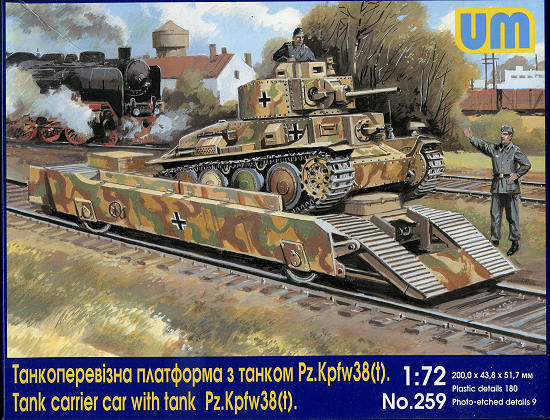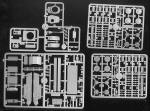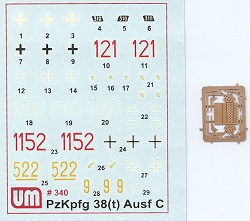
UM 1/72 Tank Carrier Car and PzKpfw 38(t)
| KIT #: | 259 |
| PRICE: | $18.45 from www.scale-model-kits.com |
| DECALS: | One option |
| REVIEWER: | Scott Van Aken |
| NOTES: |

| HISTORY |
The Panzer 38(t) was a conventional pre-World War II tank design, with riveted armour and rear engine. The riveted armour was mostly not sloped, and varied in thickness from 10 mm to 25 mm in most versions. Later models (Ausf. E on) increased this to 50 mm by bolting on an additional 25 mm armour to the front. Side armours received additional 15mm armour from Ausf. E onward.
The two-man turret was centrally located, and housed the tank's main armament, a 37 mm Skoda A7 gun with 90 rounds stored onboard. It was equipped with a 7.92 mm machine gun to the right of the main ordnance. This turret machine gun was in a separate ball mount rather than a fixed coaxial mount. This meant the machine gun could be trained on targets independently. Alternatively, the commander/gunner could couple the machine gun internally to the main gun and use it as a coaxial machine gun. The driver was in the front right of the hull, with the bow machine-gunner seated to the left, manning a 7.92 mm machine gun. As with many 1930s tanks, the bow gunner was also the radio operator. The radio was mounted on the left of the bow gunner.
The Royal Armoured Corps (RAC) had one trial model delivered on March 23, 1939 to Gunnery School at Lulworth. A report stated, the "(bow) gunner could not sit back comfortably as the wireless set was in the way of his left shoulder." The report also states that the due to the judder on the move, it was impossible to lay the gun on the move, and that even at 5 mph, shooting was poor. As a result, the RAC did not purchase the Panzer 38(t) and the trial model was returned.
Minor adjustments, such as adjustable seats for the driver and firmer footing for the commander/gunner and loader was provided in German service. A total of 2,550 rounds were carried for the bow and turret machine guns. The driver could also fire the hull machine gun with a trigger fitted on the left tiller bar.
In German service, a loader position was added to the turret by reducing ammunition capacity by 18 rounds. All future Panzer 38(t) tanks were rebuilt according to this specification, whereas those already in service were modified accordingly. The commander had to aim and fire the main gun.
The engine was mounted in the rear of the hull and drove the tank through a transmission with five forward gears and one reverse gear to forward drive sprockets. The track ran under four rubber-tired road wheels and back over a rear idler and two track return rollers. The wheels were mounted on a leaf-spring double-bogie mounted on two axles. Despite the large wheel size, the tank did not use a Christie suspension.
| THE KIT |
UM's kit takes their already nicely done Panzer 38(t) and combines it with a railway tank carrier car. According to the kit instructions, these were more than just ways to move the tank from place to place. They were also used at the front and rear of trains to provide protection against attack from ground troops or partisans.
 The tank itself is identical to one previewed earlier. To recap, Molded in grey plastic, this kit is of the same good quality as other UM kits. Thanks to the design of this tank, the usual mass of
The tank itself is identical to one previewed earlier. To recap, Molded in grey plastic, this kit is of the same good quality as other UM kits. Thanks to the design of this tank, the usual mass of  road wheels and return rollers isn't present. The injected plastic track has individual links where it goes over the sprockets, but otherwise is a nice solid track. The small etched fret is for a perforated box on the right side fender and for fender braces. Those parts not used in this variant are few and clearly shown in the instructions. Only molding glitch of note are two large sink holes in the bottom of the hull. These can easily be filled but are deep so multiple applications will probably be needed. The rest of the build looks pretty normal for these kits. As usual, there is a small photo etch fret included. The tank in this kit is minimally marked with no individual numbers, though you do have a number of options included on the sheet.
road wheels and return rollers isn't present. The injected plastic track has individual links where it goes over the sprockets, but otherwise is a nice solid track. The small etched fret is for a perforated box on the right side fender and for fender braces. Those parts not used in this variant are few and clearly shown in the instructions. Only molding glitch of note are two large sink holes in the bottom of the hull. These can easily be filled but are deep so multiple applications will probably be needed. The rest of the build looks pretty normal for these kits. As usual, there is a small photo etch fret included. The tank in this kit is minimally marked with no individual numbers, though you do have a number of options included on the sheet.
 The other part of the kit is the railway car for the tank. There are four grey sprues for this one, with two of the sprues being identical for the wheel set. A typical European car, it has but four wheels. There are two sections of track to put together on which to display the car. The main body of this car is rather liberally covered with ejector pin marks. Now if you are going to keep the tank in it, some of these will be covered up, but others will not and so they will have to be removed. There are some on the side pieces as well as the ramp sections. A few sink areas are also on some pieces. This is all in all, pretty typical stuff for these sorts of kits and those building them will have experience taking care of these minor issues.
The other part of the kit is the railway car for the tank. There are four grey sprues for this one, with two of the sprues being identical for the wheel set. A typical European car, it has but four wheels. There are two sections of track to put together on which to display the car. The main body of this car is rather liberally covered with ejector pin marks. Now if you are going to keep the tank in it, some of these will be covered up, but others will not and so they will have to be removed. There are some on the side pieces as well as the ramp sections. A few sink areas are also on some pieces. This is all in all, pretty typical stuff for these sorts of kits and those building them will have experience taking care of these minor issues.
Instructions are quite well done with UM's usual superbly drawn construction steps. There are 23 in all, covering both items. Color information is provided with Humbrol references and this includes colors to be applied during construction. The single markings option as shown on the box art is for armored train #64, Warsaw, 1944. colors are a base of panzer tan with large sections of green and brown. The decal sheets are well printed and should work well.
| CONCLUSIONS |
A most unusual presentation for most armor builders. UM has quite a selection of rail cars and locomotives in its collection and this one just adds to it. A great way to provide some interest to what is usually found on one's display shelves.
| REFERENCES |
http://en.wikipedia.org/wiki/Panzer_38%28t%29
September 2010
Thanks to www.scale-model-kits.com for the preview kit. Get yours at the link and at a discount.
If you would like your product reviewed fairly and fairly quickly, please contact the editor or see other details in the Note to Contributors.